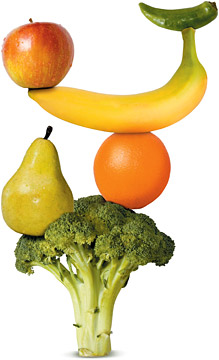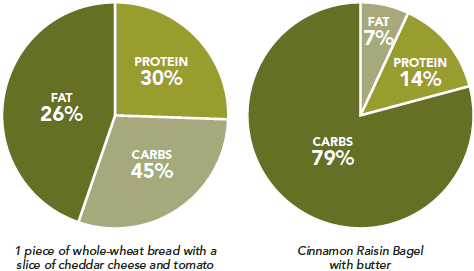Healthy Eating: A Matter of Balance
By Sara Tiner
Without proper balance, even a seemingly healthy diet won't provide you with the nutrition your body needs.
With food at every turn, Americans seem to have surmounted the age-old problem of not getting enough to eat. But both deficiency and over-consumption of foods are still a problem in some groups of people. Dietary surveys and research reveal that the elderly, those who are extremely poor, alcoholics, and people who strictly limit food intake by choice can all be in danger of becoming deficient in
vitamins and minerals needed for proper body functioning.
But more common are the problems associated with overconsumption of food. Eating more than the body needs for daily repair and growth can lead to obesity, which in turn is implicated in a host of diseases related to the heart and cardiovascular system, cancer and diabetes. And unlike the genetics, gender, or age, diet is something we can control and use for our benefit. That's why making healthy dietary choices is so important - your quality of life can literally depend on it.
 Why Balanced Eating Is So Important to Good Health
Why Balanced Eating Is So Important to Good Health
Unlike plants, we can't use sunlight to make our own food (wouldn't that be neat?). We need to take in nutrients that our body can then break apart and use to fuel the millions of biochemical reactions that keep us moving, growing and learning. Our food needs to give us energy now (the body prefers carbohydrates for this), provide building blocks for repair (proteins that break down into amino acids), and allow us to store energy for later (fats). But we also need vitamins and minerals - these complex substances are needed for chemical reactions in the body (like the B-vitamin complex and its action in energy generation and enzyme activity), and in some cases make up part of our physical structure (calcium in bones, for example).
Balanced eating means taking in the amount of nutrients your body needs for optimal functioning, when your body needs it, and no more. Simple to understand, hard to do! Every person requires different levels of nutrient intake, and your age, activity level, whether you're a man or woman, and your current weight all play a role in what your plate should look like. One thing is for sure, though: It shouldn't look like one big bagel. Here's why.
Unbalanced Eating: Too Much of Some Nutrients, Not Enough of Others
Not to pick on bagels, but in general, they're unbalanced -nutritionists would call this "calorie dense / nutrient light," meaning that within a medium, cinnamon-raisin bagel with butter, most of the 314 calories come from one nutrient: carbs. Exchange that bagel for something like a slice of whole-grain bread with cheese and tomato and you get a more balanced profile of nutrients and a lot more vitamins and minerals - key to a nutrient-dense food. And nutrient density is what you want.
Balanced vs. unbalanced eating: A classic example
Think bagels are healthy? Maybe compared to a donut, but they’re
nutritionally unbalanced compared to whole-wheat toast with cheese and
tomato. Take a look (and see the table on the next page for a more
detailed breakdown):


